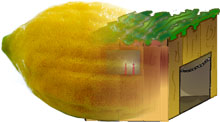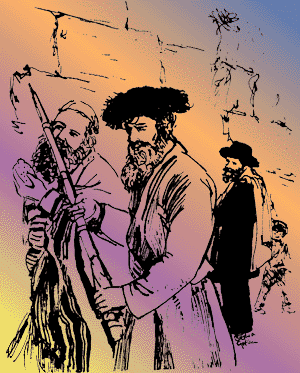The Succah and the Four Species

At first sight, the mitzvos of the festival of Succos seem to be divided into two distinct categories: The succah on the one hand, and the four species (the lulav, esrog, hadas and arava) on the other. Is there a connection between the two?
Let's
answer one question with another: Why do we go out and live in a Succah
after Yom Kippur?
On Rosh Hashana, Hashem judges the world, and on Yom Kippur He seals the
decree. Now, it may be that He has decreed that the Jewish People go into
galus (exile). So we make ourselves a succah and "exile"
ourselves from our homes, and Hashem considers this as though we had in
reality gone into exile.
This is a very strange idea - how can it be, that by merely walking a few meters from our houses it is as though we had gone into exile? ...and what a pleasant exile at that! Let us try and understand how the "exile" of the succah works.
The Distance Between Us

Another question: What makes people distant from each other?
Answer: The desire to take, to grab.
The underlying rationale of acquisitiveness is that whatever you have depletes from what I have. In other words - you are using my space, you are breathing my air, you are filling up my world! Everything you have means I have less! When a person feels like this, the very existence of other people bothers him. This is what is called Sinas Chinam - baseless hatred. Sinas Chinam brings exile to the Jewish People - two thousand years ago, the Second Beis Hamikdash was destroyed and we were exiled and dispersed all over the world because of Sinas Chinam.
But the punishment for Sinas Chinam - exile - is also its cure. Exile causes a person to feel rootless and de-stabilized, and inevitably this negates his trait of acquisitiveness. The feeling that others are depriving me from what is rightfully mine is replaced by a feeling of unity, of "I may have very little - but you are welcome to share it!" And so the punishment of exile cures the separation between people.
The succah represents the nullification of material power and acquisitiveness - however wealthy a person may be, he is obliged to leave the realm of his wealth, his house and all its symbols of power and status - all the things that make him think that the world is his - and dwell in a temporary dwelling. Destabilized, he feels how much he needs Hashem to protect him - that his own power is nothing. He dwells under the "shade of faith." By living in a temporary dwelling, he sensitizes himself to the very temporary nature of his dwelling in this world.
This creates the sense of vulnerability and instability which
is the hallmark of exile. It is this feeling of exile which unifies
the Jewish People and nullifies the selfishness that leads to Sinas
Chinam, which was the reason for the verdict of exile in the first
place. And, remarkably, by moving just a few meters out of our homes, we
have in reality experienced galus.
Another Way to Unity...
But how do the Four Species fit into the picture?
 The Four
Species represent four types of Jew. The lulav is from a palm
tree - the palm has no smell, but it has fruit - the date. It represents
the Jew who has Torah learning but doesn't observe the mitzvos.
The hadas (myrtle) has fragrance but no fruit - that's the Jew who
keeps mitzvos but has no Torah learning. The esrog has fragrance
and is also an edible fruit - that's someone who has both Torah and mitzvos;
and the arava (willow) has neither fruit nor smell - he has neither
Torah nor mitzvos. Hashem says that it is impossible for any of
these types to be lost - rather they should be "bound together"
- like the Four Species (which we bind together). Then, the ones
with Torah and mitzvos will atone for those who have neither, and
the merit of those who had neither Torah nor mitzvos will be that
they were the means, the vessel by which the others could do the mitzvah
of elevating them through being joined together with them. The end result
is that unity reigns amongst the Jewish People. They are bound together
like the Four Species. The succah and the four species
- two ways to unity.
The Four
Species represent four types of Jew. The lulav is from a palm
tree - the palm has no smell, but it has fruit - the date. It represents
the Jew who has Torah learning but doesn't observe the mitzvos.
The hadas (myrtle) has fragrance but no fruit - that's the Jew who
keeps mitzvos but has no Torah learning. The esrog has fragrance
and is also an edible fruit - that's someone who has both Torah and mitzvos;
and the arava (willow) has neither fruit nor smell - he has neither
Torah nor mitzvos. Hashem says that it is impossible for any of
these types to be lost - rather they should be "bound together"
- like the Four Species (which we bind together). Then, the ones
with Torah and mitzvos will atone for those who have neither, and
the merit of those who had neither Torah nor mitzvos will be that
they were the means, the vessel by which the others could do the mitzvah
of elevating them through being joined together with them. The end result
is that unity reigns amongst the Jewish People. They are bound together
like the Four Species. The succah and the four species
- two ways to unity.
by Rabbi Yaakov Asher Sinclair






